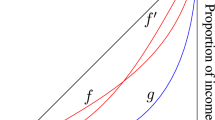Abstract
Correcting household survey distribution data for missing income or for undersampling may give an idea of the extent of possible biases in measuring inequality, especially when there are reasons to expect the missing income and people to belong to the top of the distribution. There are simple ways to do so when only an aggregate estimate of how much is missing is available. Atkinson had provided a formula to correct the Gini coefficient for the missing income, which was later generalized by Alvaredo (Econ. Lett. 110(3), 274–277 2011). This paper concentrates on the whole distribution and explores various alternative adjustment methods based on three key parameters: how much income, how many people are missing and on what range of income the correction should bear.
Similar content being viewed by others
References
Alvaredo, F.: The Rich in Argentina over the Twentieth Century, 19322004. In: Atkinson, A.B., Piketty, T. (eds.) Top Incomes: a Global Perspective. Oxford University Press, Oxford (2010)
Alvaredo, F.: A note on the relationship between top income shares and the Gini coefficient. Econ. Lett. 110(3), 274–277 (2011)
Alvaredo, F.A., Londoño Vélez, J.: Altos ingresos e impuesto de renta en Colombia, 1993-2010, Revista de economía Institucional, Universidad Externado de Colombia, 16(31), pp. 157–194 (2014)
Anand, S., Segal, P.: The Global Distribution of Income. In: Atkinson, A.B., Bourguignon, F. (eds.) Handbook of Income Distributtion, vol. 2. Elsevier, North-Holland, Amsterdam (2015)
Atkinson, A.B.: Measuring Top Incomes: Methodological Issues. In: Atkinson, A., Piketty, T. (eds.) Top Incomes over the Twentieth Century: a Contrast between Continental European and English-Speaking Countries. Oxford University Press, Oxford (2007)
Atkinson, A.B.: Pareto and the Upper Tail of the Income Distribution in the UK: 1799 to the Present, Economica, 84, p. (2017)
Atkinson, A.B., Bourguignon, F.: Introduction: Income Distribution and Economics. In: Atkinson, A.B., Bourguignon, F. (eds.) Handbook of Income Distribution, vol. 1. Elsevier, North-Holland, Amsterdam (2000)
Blanchet, T., Fournier, J., Piketty, T.: Generalized Pareto curves: Theory and applications, WID.world working paper N∘ 2017/3 (2017)
Bourguignon, F.: Appraising income inequality databases in latin america. J. Econ. Inequality 13(4), 557–578 (2015)
Burkhauser, R., Feng, S.H., Jenkins, S., Larrimore, J.: Recent trends in top income shares in the USA: reconciling estimates from March CPS and IRS tax return data. Rev. Econ. Stat. 94(2), 371–388 (2012)
Cowell, F., Flachaire, E.: Statistical Methods for Distribution Analysis. In: Atkinson, A.B., Bourguignon, F. (eds.) Handbook of Income Distribution, vol. 2. Elsevier, North-Holland, Amsterdam (2015)
Deaton, A.: Measuring poverty in a growing world (or measure growth in a poor world). Rev. Econ. Stat. 87(1), 1–19 (2005)
Jenkins, S.: Pareto models, top incomes and recent trends in UK income inequality. Economica 84(334), 261–269 (2017)
Korinek, A., Mistiaen, J., Ravallion, M.: Survey nonresponse and the distribution of income. J. Econ. Inequality 4, 3355 (2006)
Lakner, C., Milanovic, B.: Global Income Distribution: from the Fall of the Berlin Wall to the Great Recession. World Bank Econ. Rev. 30(2), 203–32 (2015)
Lustig, N.: The mising rich in household surveys: causes and correction approaches, Working Paper 75, CEQ Institute, Tulane University (2017)
Morgan, M.: Falling Inequality beneath Extreme and Persistent Concentration: New Evidence for Brazil Combining National Accounts, Surveys and Fiscal Data, 2001-2015, WID.world, Working Paper Series, N∘ 2017/12 (2017)
Szekely, M., Hilgert, M.: What’s behind the Inequality We Measure: an Investigation Using Latin American Data, Working paper, Inter-American Development Bank (1999)
Yitzhaki, S.: Do we need a separate poverty measurement?. Eur. J. Polit. Econ. 18(1), 61–85 (2002)
Author information
Authors and Affiliations
Corresponding author
Additional information
This paper benefited from useful comments by the editors of this issue of the Journal of Economic Inequality, Cecilia Garcia-Penalosa and Facundo Alvaredo.
Appendices
Appendix A: Proof of (7)
Integrating (5) yields:
But δ can be expressed as:
and Eq. 7 follows:
We now show that the second term in the bottom row of that expression is that of the Lorenz curve of the distribution of \(z=x-x(\overline {p}\)). Define \(q=(p-\overline {p})/(1-\overline {p})\), which thus varies in [0, 1]. The quantile function of z is given by \(z(q)=x[(1-\overline {p})q+\overline {p}]-x(\overline {p})\). The Lorenz curve of z is then given by:
With a change of variable in the first integral it can be shown that:
Or:
Then noticing that \(X(\overline {p})-x(\overline {p})=\frac {1-L(\overline {p})}{1-\overline {p}}\overline {x}-x(\overline {p})\) the preceding expression can be rewritten as:
which is the term that appears in the the second row of Eq. 7. Integrating this expression with respect to q in (0,1), or p in \((\overline {p},1)\) yields \((1-p)(1-\widetilde {G})/2\), where \(\widetilde {G}\) is the Gini coefficient associated to z. Doing the same with L(p) in (0,1) yields (1 − G)/2. Integrating L∗(p) thus leads to:
Eq. 8 follows.
Appendix B: Proof of (12)
A useful property to be used in what follows is:
Integrating the top part of the expression of the quantile function:
dividing by the mean of the corrected distribution and using (18) leads to:
Doing the same on the bottom part of the expression of the quantile function yields:
Then, noticing that Eq. 19 implies \(L^{*}[\overline {p}.(1-\lambda )]=\frac {1-\lambda }{1+\mu }L(\overline {p}\)), Eq. 12 follows.
Rights and permissions
About this article
Cite this article
Bourguignon, F. Simple adjustments of observed distributions for missing income and missing people. J Econ Inequal 16, 171–188 (2018). https://doi.org/10.1007/s10888-018-9388-8
Published:
Issue Date:
DOI: https://doi.org/10.1007/s10888-018-9388-8



